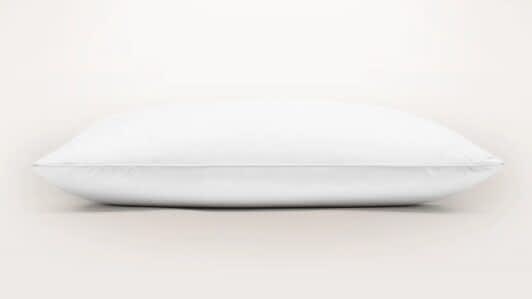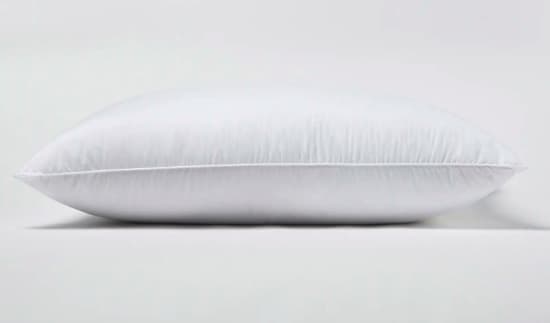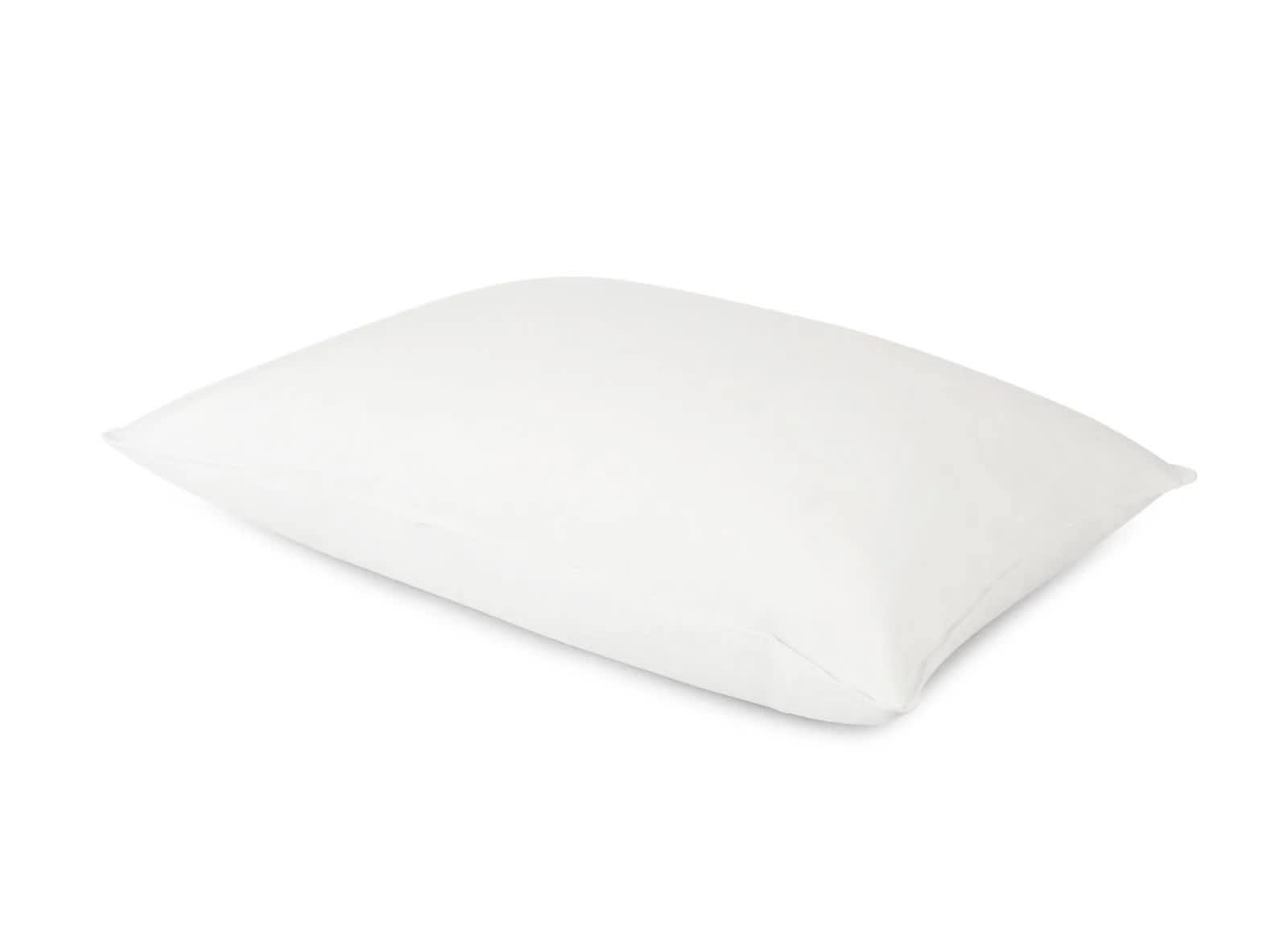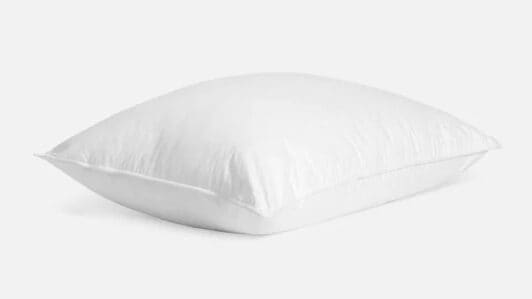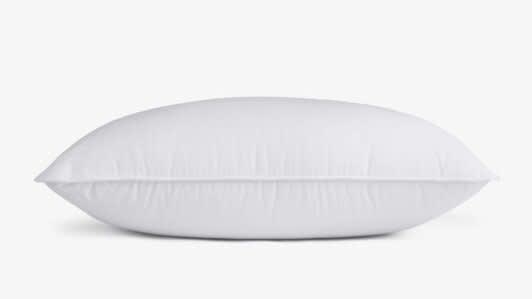Standard and queen size down pillows typically cost between $80 and $200. Down pillows tend to be more expensive than the average pillow because of their quality. However, the price varies significantly based on the type of down and the ratio of down to feathers. Goose down pillows usually carry higher price tags than those that contain duck down. Pillows with higher feather-to-down ratios are often more budget friendly.
On This Page
The Best Down Pillows of 2025
Our Top Picks
-
Best Overall
Boll & Branch Down Pillow -
Best Goose Down
Quince Luxe Goose Down Pillow -
Best Value
Helix Down & Feather Pillow -
Best for Side Sleepers
Brooklinen Down Pillow -
Best Luxury
Parachute Down Pillow
Best Overall
Highlights
Highlights
- Available in three density levels
- Three-chamber construction for support and softness
- Triple-washed down and feathers
Ideal For
- Sleepers with distinct firmness needs
- Combination sleepers
- Those interested in ethically sourced down
Full Details
Best Goose Down
Highlights
Highlights
- Available in two firmness levels
- 700 fill power down fill for fluffiness
- Responsible Down Standard certified
Ideal For
- Stomach, back, and side sleepers
- Sleepers experiencing neck and shoulder discomfort
- Those who value ethically sourced down
Full Details
Best Value
Highlights
Highlights
- Three-chamber design for balanced comfort and support
- Soft but supportive
- Responsible Down Standard certified
Ideal For
- Side and back sleepers
- Stomach sleepers less than 130 pounds
- Those who like conforming and moldability
Full Details
Best for Side Sleepers
Highlights
Highlights
- Available in three firmness levels
- Antimicrobial treatment designed to inhibit bacterial, mold, and mildew growth
- Sourced and manufactured in Canada
Ideal For
- All sleeping positions
- Sleepers who want a plush yet supportive feel
- Those with allergies
Full Details
Best Luxury
Highlights
Highlights
- 750 fill power and 7-inch loft for a full shape
- Fluffy European white down
- Available in three firmness levels
Ideal For
- Side and back sleepers
- Those who want a moldable pillow
- Luxury shoppers
Full Details
How We Test Pillows
There’s a reason down pillows have been popular for hundreds of years – they’re fluffy, squishy, breathable, and comfortable for a wide range of sleepers. Because there are so many down pillow models available, it’s critical to use standardized trials to compare their performances. Our team examines how a model feels for a range of sleeping positions and body weights to determine support. We also look at the down fill’s power, quality, ratios, and sourcing – which are all important factors that can set down pillows apart from one another.
What Is Down?
Down is a common pillow fill material consisting of soft fibers from the underbelly of waterfowl, such as ducks and geese. These fibers form light and fluffy clusters with nearly undetectable quills.
While down is technically a type of feather, it is distinctly different from standard feathers. Feathers are denser, making up the outer layer of a waterfowl’s wings and back. Individual feathers consist of a prickly quill surrounded by velvety fibers.
Down fill typically creates a light, fluffy, moldable pillow that retains warmth. Sleepers who prefer a cloud-like feel often favor down. In contrast, feather pillows are generally firmer and more breathable. Those who sleep hot or need more support may prefer this fill. Many pillows use a combination of down and feathers to balance support, softness, and temperature regulation.
Because down is so moldable and fluffy, it’s important to buy a pillow with a loft level that supports your neck even once the pillow compresses. Side sleepers will want thicker pillows than back and stomach sleepers to prevent their necks from bending.
What Should You Know About Down Pillows?
Before purchasing a down pillow, sleepers should understand their cost, adjustability options, ease of care, and fill ratio. While these additional factors may be easy to overlook, they can make a big difference in determining the best pillow for you.
How Much Do Down Pillows Cost?
Are Down Pillows Adjustable?
Most down pillows are not adjustable. Sleepers should refrain from removing or adding fill unless the manufacturer explicitly suggests it. Taking out the fill could permanently damage the pillow. In place of customizable fill, many brands offer several loft or firmness options to accommodate different sleep positions.
Can You Wash a Down Pillow?
Depending on its construction, a down pillow may or may not be machine-washable. The harsh movement of washing machines can damage the shells of some pillow models, so spot cleaning and dry cleaning are often preferable. However, other down pillows can be washed and dried on a gentle cycle. Double-check the manufacturer’s care instructions to ensure you properly care for your down pillow.
Do Down Pillows Contain Feathers as Well?
Down vs. Down Alternative in Your Pillows
Down alternative mimics the fluffy softness of down but consists of cotton or synthetic fill, like polyester. Because it does not have animal products, down alternative is hypoallergenic. Pillows that contain down alternative fill are frequently more affordable and more breathable than down models. They’re also often machine-washable. However, down alternative pillows tend to be less durable, and quality varies widely depending on the specific fill material.
Down vs. Down Alternative
| Down | Down Alternative | |
| Description | Harvested from the underbelly of waterfowl, down clusters are soft and airy. The fill creates a light and fluffy pillow that conforms to the head with a cloud-like feel. | Down alternative fill uses cotton or synthetic fibers to imitate down’s softness and plushness. While the material feels similar to down, it tends to be more breathable but less durable. |
| Pros |
|
|
| Cons |
|
|
Duck Down vs. Goose Down in Your Pillows
There are two main types of down commonly used in pillows: duck and goose. Although both share similar properties, the two vary in their quality and performance.
Duck down clusters are traditionally smaller than goose down clusters, so the resulting pillows generally aren’t as fluffy or insulating. Because ducks are closer to the ground, the down is also more susceptible to collecting allergens and retaining odors. However, duck down is readily available, making the material more affordable.
Goose down’s larger clusters are typically softer and retain more heat. Despite its plush texture, goose down holds its shape better than duck down. This lends to lofty, durable pillows. Goose down is also less prone to odors and allergens. Since the material is in high demand but less widely available, goose down pillows usually have a higher price tag.
How Do You Know if the Down in Your Pillow Is Ethically Sourced?
Because down is a byproduct of animal agriculture, ethical sourcing is a major concern. Some production methods subject birds to unnecessary pain, stress, and suffering. Relevant certifications can verify that your pillow’s down fill was produced with consideration of animal welfare.
- Responsible Down Standard (RDS): This certification ensures the manufacturer has met strict criteria pertaining to the full production chain, from animal breeding through product manufacturing.
- DOWNPASS: This zero-tolerance standard uses extensive auditing for product quality monitoring.
- Global Traceable Down Standard (Global TDS): Global TDS implements systems for supply chain transparency to verify responsible sourcing.
Upcycling is another popular option to minimize the impact on animals and reduce waste. Owners often dispose of pillows, jackets, duvets, and other products that contain down when the shell becomes damaged. However, the down itself is quite durable. Upcycled down pillows contain previously used down that’s been carefully washed, sterilized, and sorted for quality and cleanliness.
If ethical down sourcing is important to you, look for certifications from third parties that advocate for humane animal treatment and responsible sourcing. You can go even further by buying pillows made from upcycled down jackets and blankets.
Explore More Pillows
If you’re looking for a particular type of pillow, check out our other guides below.
More Pillows by Fill
- Best Bamboo Pillows
- Best Buckwheat Pillows
- Best Down Alternative Pillows
- Best Feather Pillows
- Best Latex Pillows
- Best Memory Foam Pillows
- Best Polyester Pillows
Pillow Height, Firmness, Support, and Keeping Your Spine Aligned
The right pillow loft and firmness are critical to keeping your spine aligned. Your sleeping position is the primary factor that determines what works best for you.
Your Pillow’s Height (or Loft)
Loft refers to a pillow’s height or thickness. Low-loft pillows are 3 inches or less, medium-loft options are between 3 and 5 inches, and high-loft designs are more than 5 inches. Since a pillow should fill the space between your head, neck, and the bed, the ideal loft depends on your sleep position.
How Firm Should Your Down Pillow Be?
Firmness level refers to how soft or hard the pillow feels. Although down pillows are generally on the softer side, they come in several firmness levels based on the density and type of fill. The pillow firmness level contributes to the overall support.
Pillow Support and Keeping Your Spine Aligned
Support refers to the pillow’s ability to promote spinal alignment, which is integral to healthy, pain-free sleep. Improper spinal alignment can lead to restless sleep, neck pain, and muscle tension. Sleepers should choose the right pillow for their sleeping position to support good posture and promote quality sleep.
Firmness level and loft determine a down pillow’s level of support. For instance, side sleepers typically require firmer, high-loft pillows for optimal support. Stomach sleepers generally benefit from soft to medium, low-loft pillows. Back sleepers tend to fall right in the middle.
Body type and mattress firmness also come into play. If you sink deeply into your mattress, you won’t need as much support from a pillow because your head is already closer to the mattress surface. However, if your mattress is firm for your body type, you may need a more supportive pillow to fill the gap under your head.
We recommend carefully assessing your needs to find the ideal down pillow for you.
